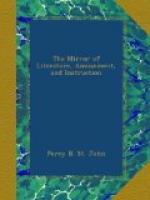The “bone” of the Cuttle-fish now claims attention. This is a complicated calcareous plate, lodged in a peculiar cavity of the back, which it materially strengthens. This plate has long been known in the shop of the apothecary under the name of Cuttle-fish bone: an observant reader may have noticed scores of these plates in glasses labelled Os Sepiae. Reduced to powder, they were formerly used as an absorbent, but they are now chiefly sought after for the purpose of polishing the softer metals. It is however improper to call this plate bone, since, in composition, “it is exactly similar to shell, and consists of various membranes, hardened by carbonate of lime, (the principal material of shell,) without the smallest mixture of phosphate of lime,[13] or the chief material of bone.”
[12] According to Cuvier, the Indian
ink, from China, is made of
this fluid, as was the ink of the Romans.
It has been supposed,
and not without a considerable degree of
probability, that the
celebrated plain, but wholesome dish, the
black broth of Sparta,
was no other than a kind of Cuttle-fish soup,
in which the black
liquor of the animal was always added as
an ingredient; being,
when fresh, of very agreeable taste.—Shaw’s
Zoology.
[13] Mr. Hatchett, in Philos. Trans.
EGGS.
[Illustration: Eggs.]
Lastly, are the ovaria, or egg-bags of the Cuttle-fish, which are popularly called sea-grapes. The female fish deposits her eggs in numerous clusters, on the stalks of fuci, on corals, about the projecting sides of rocks, or on any other convenient substances. These eggs, which are of the size of small filberts, are of a black colour.
The most remarkable species of Cuttle-fish inhabits the British seas; and, although seldom taken, its bone or plate is cast ashore on different parts of the coast from the south of England to the Zetland Isles. We have picked up scores of these plates and bunches of the egg-bags or grapes, after rough weather on the beach between Worthing and Rottingdean; but we never found a single fish.
The Cuttle-fish was esteemed a delicacy by the ancients, and the moderns equally prize it. Captain Cook speaks highly of a soup he made from it; and the fish is eaten at the present day by the Italians, and by the Greeks, during Lent. We take the most edible species to be the octopodia, or eight-armed, found particularly large in the East Indies and the Gulf of Mexico. The common species here figured, when full-grown, measures about two feet in length, is of a pale blueish brown colour, with the skin marked by numerous dark purple specks.
The Cuttle-fish is described by some naturalists, as naked or shell-less. It is often found attached to the shell of the Paper Nautilus, which it is said to use as a sail. It is, however, very doubtful whether the Cuttle-fish has a shell of its own. There is a controversy upon the subject. Aristotle, and our contemporary, Home, maintain it to be parasitical: Cuvier and Ferrusac, non-parasitical; but the curious reader will find the pro and con.—the majority and minority—in the Magazine of Natural History, vol. iii. p. 535.




